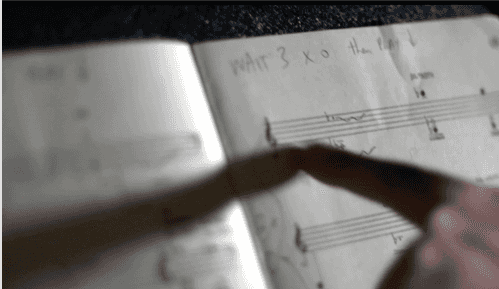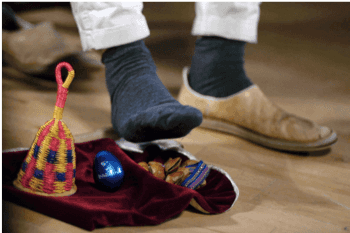The orchestra parts
Introduction

Each of the solos (with the exception of the Solo for Piano) that form the Concert for Piano and Orchestra consists of 12 or 16 pages of notation and a single page of instructions. The notations and instructions of each part follow very similar principles but there are differences. Of course, many of those differences are to do with the different sounds the instruments produce and the way they produce them: that’s one reason why all of the string parts (excluding the bass parts) can have identical instruction pages. But there are also stranger and more subtle differences from part to part. One example is the way that Cage insists that string players may not repeat pages, a diktat which does not appear in the other parts. Another case is that all the parts except the strings are allowed to introduce ‘additional silences’. As a result, we present separate texts and films for each instrument, except for the string instruments, which are grouped together, and discuss below principles and features common to all the solos.
The page
All the events on a single page are the result of Cage inscribing points at places where he observed imperfections on paper, then combining these with musical staves to turn points into notes, and a number of chance processes which add technical and musical detail to these notes. The page, then, simply frames a randomly selected number of sounds, from no sounds—an empty page—up to 36 sounds. This means that, like many of Cage’s pieces from the 1950s, the page acts as both container and form for the music (though in fact Cage sketched the parts on a page equivalent to two pages of the published music, subsequently dividing his manuscript page into two halves, which is why pairs of pages, on the whole, contain similar densities of sounds).
For suggestions as to adding timings to parts, see Performing the Concert.
Interpreting the size of notes

All sounds, including those notated above and below the staves, are represented by notes of one of three sizes. These represent differences of either duration or dynamic or both. Small notes are either short in duration or quiet in dynamic or both. Large notes are either long in duration or loud in dynamic or both. The instructions in the string parts seem to allow large notes to be medium in duration, but because this is immediately contradicted by the next sentence, this is probably simply an error. Intuitively players may be drawn to playing large notes loudly and small notes softly, but it is always worth remembering that this is not necessary and that the option for duration may always be used, such that a large note may be played very quietly for a long time.
Although Cage makes no reference in the instructions as to how to read the spacing of the notes across a system, in his programme note to the first performance he wrote ‘each part is written in detail in a notation where the space is relative to time determined by the performer and later altered by a conductor’. How the player negotiates the space-time continuity with the options for duration provided by the note sizes is one of the most interesting challenges of performing the solos. It may be that observing as accurately as possible the spatial relationships of notes influences decisions as to duration, such that if a system with a large number of notes is to be played within a short period of time then large noteheads will be likely played as short sounds rather than long sounds.
One of the few instructions in all solos which would appear to be non-negotiable affects how one sound relates to another: ‘All notes are separate from one another in time, preceded and followed by a silence (if only a short one).’ (The bracketed addition is absent from the Solo for Bass.) The instruction is clear: no sound should be joined to another, such that legato phrases or gestures might be imposed upon the sequences of sounds. The emphasis is upon the execution of each sound, with its often multiple properties, regardless of the qualities of the previous and consequent sound. Cage does provide some indication, however, of where exceptions might be made: the Solo for Bass instructions include ‘Exceptions may be made where sounds can be produced while an earlier sound is continuing (superimposition). One sound, however, should not move melodically to another.’ And the Solo for Bassoon and Baryton Saxophone adds ‘Exceptions: trills, tremolos’. Later in the instructions for other solos, Cage writes ‘Notes given duration may be played constantly or intermittently’. So although the overriding character of the Concert for Piano and Orchestra is of individual sounds bounding around the performance space, across instruments, there is also scope for sustained and continuously broken and volatile sounds. Link to section of film on size of noteheads [16:56]
Noises
All the solos include some notes which are above or below the stave, without leger lines, indicating that these are noises to be made. Exactly where these are placed makes no difference to the noise to be produced—so those notated above the stave do not mean that they should be higher noises than those notated below the stave—rather, they are just a consequence of the compositional process (i.e. points at places where Cage observed imperfections on paper). These are used differently across the solos, so that some instruments are given freedom to apply noises of their own choice at each point (e.g. the Solo for Trumpet), while others have the noises specified in the notation (e.g. the Solo for Clarinet). Noises include those made on the body of the instrument, vocal noises, exaggerated effects, and noises made on ‘auxiliary’ sound producing means. In fact, some of the noises stipulated by Cage are not very ‘noisy’ at all, particularly some of the vocal noises or interval sounds (though they might well have sounded ‘noisier’ to contemporary audiences!). These are explored in more detail in the individual instrumental films and texts.
The works of John Cage are the copyright of Henmar Press Inc., New York and are reproduced by permission of Peters Edition Limited, London. All rights reserved.


